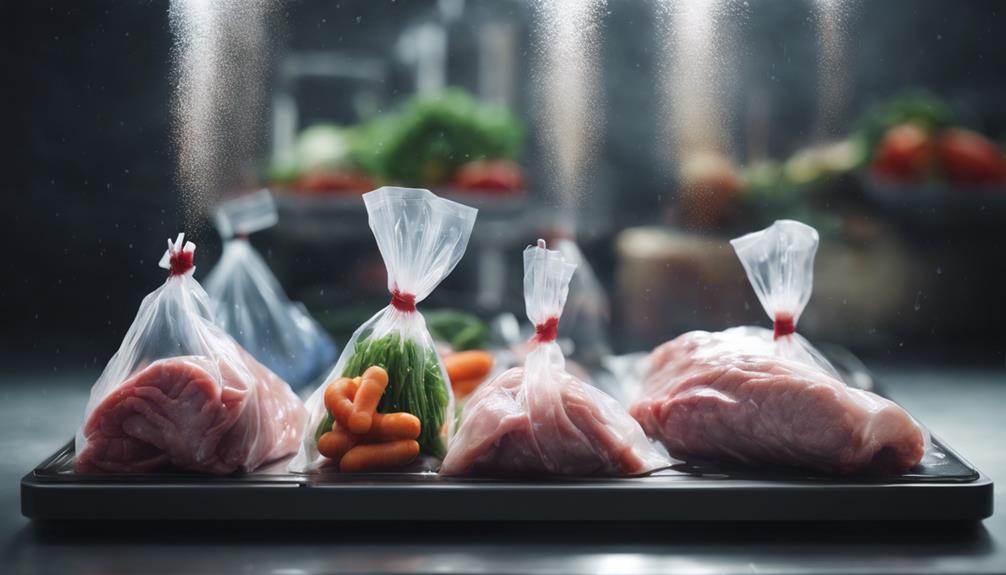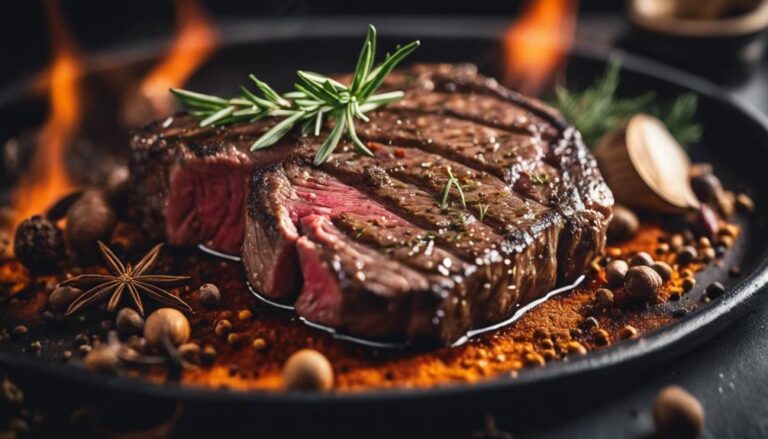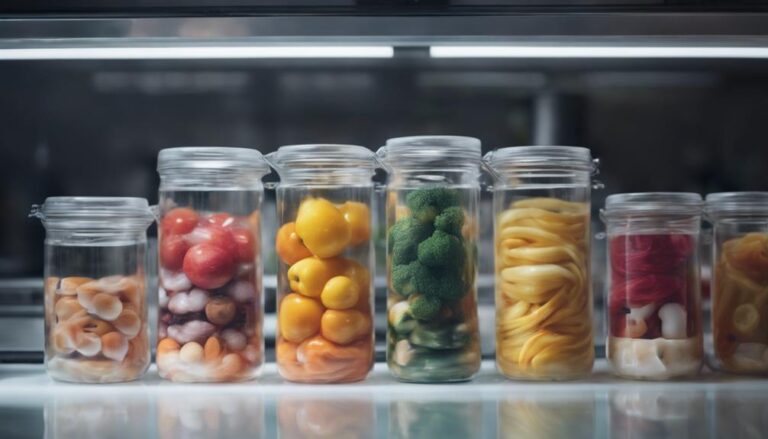Sous Vide Cooking Times Explained: A Comprehensive Guide
Mastering sous vide cooking times guarantees perfectly cooked meats with consistent results. Learn essential food safety measures, basic techniques, and recommended temperatures for fish, poultry, eggs, beef, and more. Explore the mathematics behind precise cooking and necessary equipment. Following government pasteurization guidelines is essential for safe cooking. Improve your culinary skills and meal outcomes by understanding the detailed sous vide instructions provided.
What You Will Learn Here
- Understand recommended temperatures for precise doneness.
- Follow specific cooking times for various cuts of meat.
- Ensure pasteurization through accurate heating.
- Use sous vide for consistent and controlled cooking.
- Refer to guidelines for safe cooking of beef, pork, chicken, and fish.
Food Safety Measures
To guarantee food safety in sous vide cooking, controlling pathogenic microorganisms using acids, salts, and spices is essential. Pathogens like Salmonella, E. coli, Listeria, and spore-forming bacteria can be reduced to safe levels by applying specific time and temperature combinations. Pasteurization is key in sous vide, where heating food to precise temperatures kills enough active pathogens to ensure safety. Rapid chilling and maintaining proper storage temperatures are crucial to prevent bacterial growth. Understanding the significance of precise temperature control and implementing appropriate food safety measures are critical for successful sous vide cooking.
When handling food in sous vide cooking, it's important to be mindful of the potential risks associated with bacteria. By utilizing acids, salts, and spices, you can effectively control pathogens and guarantee that your meals are safe to consume. Remember to follow specific time and temperature guidelines to reduce harmful bacteria and achieve pasteurization. Additionally, always prioritize rapid chilling and maintaining the correct storage temperatures to prevent bacterial proliferation. Your dedication to implementing these control measures won't only ensure food safety but also result in delicious and worry-free sous vide dishes for you and your guests.
Basic Cooking Techniques
Begin by mastering the fundamental cooking techniques in sous vide to elevate your culinary skills and create remarkable dishes with precision and consistency.
When you cook sous vide, it's essential to pay attention to the temperature and times recommended for different cuts of meat. Ensuring the water bath temperature is precise will help you achieve the desired level of doneness in your sous vide steak or other proteins.
By following cooking charts that provide specific time and temperature guidelines, you can guarantee that your dishes are cooked to perfection every time. This method allows for a controlled cooking environment that produces consistent results and enhances the overall quality of your food.
Fish and Shellfish Recipes
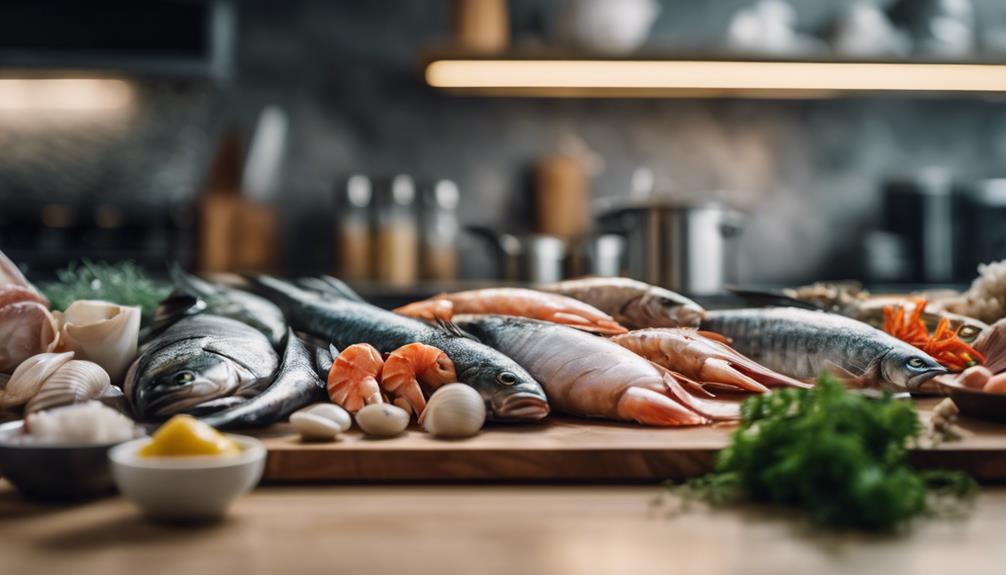
After mastering the fundamental cooking techniques in sous vide, you can explore a variety of fish and shellfish recipes to elevate your culinary repertoire. Precise temperatures play an important role in achieving the perfect tender texture for your seafood dishes. Here are some recommended sous vide cooking times and temperatures for popular fish and shellfish:
- Salmon: Cook at 122°F for 40 minutes to retain its natural flavors and moisture.
- Lobster: Sous vide the tail at 140°F for 20 minutes for perfectly tender and juicy meat.
- Halibut: Avoid overcooking by maintaining accurate temperatures throughout the cooking process.
- Scallops: Cook at 122°F for 30 minutes to make sure even cooking and maintain their delicate texture and sweetness.
Poultry and Eggs Cooking
When cooking poultry sous vide, you'll find that achieving the perfect doneness in chicken breasts and ensuring turkey tenderness is easier than ever.
For eggs, sous vide at 135°F (57.2°C) for 1 to 2 hours delivers custard-like textures and pasteurized eggs.
The controlled temperature in sous vide cooking eliminates dryness in poultry and retains the delicate texture of eggs, providing precise doneness and enhancing flavors.
Chicken Breast Doneness
For achieving perfect doneness in your chicken breast using sous vide cooking, make sure it reaches an internal temperature of 165°F (73.9°C) for safety.
Here are some key points to keep in mind:
- Precise Control: Sous vide cooking allows you to maintain precise control over the doneness of your chicken breast.
- Tender Texture: Cooking chicken breast sous vide at 140°F (60°C) for 1.5 to 4 hours can result in a tender and juicy texture.
- Food Safety: Pasteurization times for chicken breast at different temperatures help guarantee food safety by reducing pathogens.
- Moisture Content: Sous vide cooking eliminates the risk of dry, tough chicken breast by preserving ideal moisture content.
Perfect Sous Vide Eggs
To achieve perfectly creamy sous vide eggs with set whites and runny yolks, cook them at 167°F (75°C) for 13 minutes. When cooking eggs sous vide, you guarantee consistent results every time while maintaining precision temperature control. This method prevents the risk of overcooking and guarantees a delightful texture for your eggs. Ideal for dishes like Eggs Benedict, salads, or as a standalone breakfast item, sous vide eggs offer a versatile option for your menu. Additionally, the batch cooking capability of sous vide allows you to effortlessly serve a crowd with minimal effort. Embrace the ease and reliability of sous vide cooking for egg dishes that are sure to impress your guests.
| Keyword | Description | Example |
|---|---|---|
| eggs | Versatile ingredient suitable for various dishes | Eggs Benedict |
| sous vide | Cooking method that ensures precise temperature control | Sous Vide Egg Bites |
| temperature control | Maintaining exact heat levels for consistent results | Perfectly cooked eggs |
| creamy | Texture of eggs achieved through sous vide cooking | Creamy scrambled eggs |
Turkey Tenderness Tips
Need tender and juicy turkey or perfectly cooked eggs? Employing sous vide cooking at precise temperatures is your key to achieving best results effortlessly.
When it comes to turkey tenderness, sous vide cooking at 140°F (60°C) for 4-8 hours guarantees a moist and flavorful outcome. Poultry cooked sous vide retains more moisture and flavor than traditional methods, enhancing the overall taste.
Additionally, pasteurizing turkey at 140°F (60°C) for specific durations eliminates harmful bacteria, ensuring safe consumption. By cooking your turkey sous vide, you can enjoy a perfectly tender and flavorful dish that will impress your guests with minimal effort.
Beef Cooking Times
When cooking beef sous vide, it's crucial to take into account the desired doneness level. You can achieve a tender medium-rare steak by cooking at 129°F (54°C) for 1 to 4 hours.
For those who prefer a well-done piece, 160°F (71°C) for 1 to 12 hours guarantees thorough cooking while keeping the meat moist.
Adjust the cooking time based on the thickness of the cut for perfectly cooked steaks every time.
Rare, Medium, Well-Done
For achieving the desired level of doneness in your beef, consider the recommended cooking times and temperatures for rare, medium, and well-done options. Here is a breakdown to guide you:
- Rare Beef:
- Temperature Range: 120-128°F (48.9-53.3°C)
- Cooking Time: 1-2 hours
- Medium-Rare Beef:
- Temperature Range: 129-134°F (53.9-56.7°C)
- Cooking Time: 1-4 hours
- Medium Beef:
- Temperature Range: 135-144°F (57.2-62.2°C)
- Cooking Time: 1-4 hours
- Well-Done Beef:
- Temperature Range: 145-155°F (62.8-68.3°C)
- Cooking Time: 1-3 hours
Each temperature range guarantees precise doneness levels catering to different preferences. Enjoy serving perfectly cooked beef to your guests!
Temperature and Doneness
To achieve ideal temperature and doneness levels when cooking beef, adhere to the recommended cooking times and temperatures outlined for rare, medium-rare, medium, and well-done options.
For rare beef, cook at 120°F (48.9°C) for 1 to 2 hours, while medium-rare beef is achieved at 129°F (53.9°C) for 1 to 2 hours. If you prefer medium doneness, cook the beef at 135°F (57.2°C) for 1 to 4 hours. For those who enjoy their beef well-done, aim for 150°F (65.6°C) for 1 to 3 hours.
Resting Period Importance
Resting beef after sous vide cooking enhances its flavor and tenderness by allowing the juices to redistribute effectively. Here's why it's important:
- Maintains Texture: Resting beef for at least 10 minutes post-cooking helps preserve the ideal texture, ensuring a satisfying bite.
- Enhances Juiciness: Resting allows carryover cooking to finish, leading to even doneness and juiciness throughout the beef.
- Ensures Internal Temperature: Resting is essential for achieving the desired internal temperature in beef cuts, guaranteeing a perfect eating experience.
- Improves Succulence: Proper resting time impacts the overall quality and succulence of the beef, making it an essential step in sous vide cooking.
Pork Cooking Methods
Employing sous vide techniques enhances the succulence of pork, ensuring a delightful dining experience with every bite.
When preparing pork sous vide, it's crucial to take into account the suggested temperatures for different levels of doneness, ranging from 135°F (57.2°C) for medium-rare to 165°F (73.9°C) for well-done pork.
Cooking times vary based on the thickness of the cut, with 1-inch pieces typically requiring 1-4 hours and thicker cuts needing up to 12 hours to achieve ideal tenderness.
Pork can be safely pasteurized at lower temperatures like 140°F (60°C) for 4 hours, ensuring food safety while preserving the meat's natural juices and flavors.
After sous vide cooking, a quick sear can be applied to the pork to create a delicious crust, adding texture and enhancing the overall taste profile of the dish.
Mathematics of Sous Vide

Delving into the domain of sous vide cooking requires a keen grasp of the precise mathematics involved in temperature control and time calculations for safe and best culinary outcomes. To help you navigate this important aspect of sous vide cooking, here are some key points to ponder:
- Food Thickness: The thickness of your food will impact the required cooking time to guarantee even doneness throughout.
- Pasteurization Requirements: Understanding the pasteurization requirements for different foods is essential to secure food safety and eliminate harmful pathogens.
- Mathematical Formulas: Utilizing mathematical formulas specific to sous vide cooking helps in determining the core temperature needed for pasteurization and safe consumption.
- Consistency: Consistency in temperature control and time calculations is essential for achieving delicious and reliable results every time you cook sous vide.
Essential Equipment Needed
You need a water bath or immersion circulator for sous vide cooking.
Make sure to have a vacuum sealer or resealable bags on hand to seal your food properly.
A reliable thermometer is essential for monitoring water bath temperature accurately.
Equipment Overview
To successfully engage in sous vide cooking, essential equipment like an immersion circulator, water bath container, vacuum sealer bags, and a vacuum sealer machine are necessary. Here's a breakdown of the key equipment:
- Immersion Circulator: This device ensures precise and consistent water temperature, essential for achieving perfectly cooked meals.
- Water Bath Container: Choose a heat-resistant container large enough to accommodate the immersion circulator and food pouches.
- Vacuum Sealer Bags: These bags help maintain flavor retention and guarantee even cooking by sealing the food tightly.
- Vacuum Sealer Machine: Used to remove air from the bags and create a tight seal, preventing water from entering during the cooking process.
Having these tools at your disposal will elevate your sous vide cooking experience, delivering delicious results to your guests.
Tools for Precision
Moving from discussing the equipment overview, let's now focus on the necessary tools for precision in sous vide cooking. To guarantee your dishes turn out perfectly every time, you'll need the following essential equipment:
| Tools | Description |
|---|---|
| Immersion Circulator | Regulates water temperature for precise cooking |
| Digital Thermometer | Monitors water bath temperatures accurately |
| Vacuum Sealer | Secures airtight packaging for even cooking and flavor retention |
| Sous Vide Bags | Quality pouches that withstand the cooking process |
Investing in a heat-safe container or a sous vide container with a lid is also vital for maintaining water temperature stability throughout the cooking process. With these tools at your disposal, your sous vide dishes will consistently impress with their flavor and texture.
Government Pasteurization Guidelines
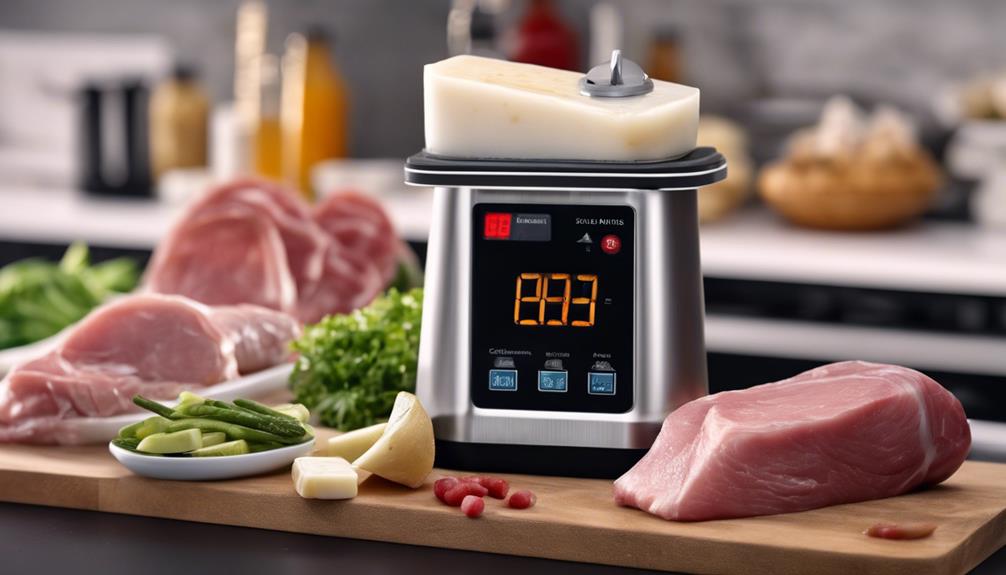
Following government guidelines, it's essential to adhere to specific pasteurization temperatures and times for beef, pork, chicken, and fish when cooking sous vide to guarantee food safety.
Here are the recommended pasteurization guidelines:
- Beef: Pasteurize at 130°F (54.4°C) for 112 minutes.
- Pork: Maintain a pasteurization temperature of 140°F (60°C) for 71 minutes.
- Chicken: Guarantee pasteurization at 136°F (57.8°C) for 63 minutes.
- Fish: Pasteurize at 122°F (50°C) for 70 minutes.
Sous Vide Steak Guide
For achieving a perfect sous vide steak, precise temperature control is key to ensuring your desired level of doneness. When preparing sous vide steak, opt for thick cuts around 1.5 to 2 inches for a juicy texture.
Searing the steak post sous vide cooking is essential to develop a flavorful crust; a torch or stovetop sear works well for this. Remember to let the sous vide steak rest before serving to allow the juices to redistribute evenly, enhancing the flavor.
Prior to vacuum sealing, season the steak generously with salt, pepper, and aromatics for a delicious end result. With sous vide cooking, you have the flexibility to achieve various doneness levels, from rare to well-done, by setting specific temperatures.
Enjoy serving juicy, flavorful sous vide steak with a perfect crust, all thanks to precise control over the cooking process.
Frequently Asked Questions
How Do I Know How Long to Cook Sous Vide?
To know how long to cook sous vide, consider factors like temperature control, cooking techniques, and food safety. By monitoring core temperatures and experimenting with different times, you can achieve flavor infusion, texture preservation, and culinary innovation.
Why Do Sous Vide Cooking Times Vary so Much?
Temperature control, meat thickness, and food safety impact sous vide cooking times greatly. Adjusting recipes, considering texture preferences, and understanding ingredient types are crucial. Proper utilization of sous vide equipment, cooking vessels, and techniques guarantees precise results.
What Happens if You Sous Vide a Steak for 5 Hours?
If you sous vide a steak for 5 hours, the meat's texture may turn extremely tender, resembling pot roast. This extended time can break down connective tissue, affecting tenderness. Follow suggested times for best juiciness, flavor, and safety.
How Do You Use Sous Vide Step by Step?
To use sous vide, start by setting precise temperatures for water immersion. Seal seasoned food for flavor infusion. Achieve protein tenderness and texture consistency through time efficiency and precision cooking. Experiment with recipes for best results.
Conclusion
So there you have it, a thorough guide to sous vide cooking times!
By following food safety measures, mastering basic techniques, and utilizing the right equipment, you can create perfectly cooked meals every time.
Whether you're cooking fish, poultry, beef, or eggs, sous vide cooking offers precise control over temperature and results in tender, flavorful dishes.
So grab your sous vide machine and start experimenting in the kitchen today!
